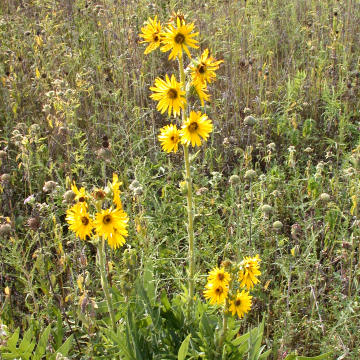

Silphium laciniatum - (image 1 of 6)
Taxonomy
Family: Asteraceae
Habitat
Prairies.
Associates
Andropogon gerardii, Aster ericoides, Aster laevis, Comandra umbellata, Convolvulus sepium, Eryngium yuccifolium, Helianthus rigidus, Hypoxis hirsuta, Lespedeza capitata, Lithospermum canescens, Parthenium intergrifolium, Petalostemum purpureum, Ratibida pinnata, Silphium intergrifolium deamii, Silphium terebinthinaceum, Solidago rigida, Sorghastrum nutans, Sporobolis heterolepsis, Stipa spartea.
Distribution
Ontario west to MN and SD, south to AL and TX. Introduced eastward along railroads to NY.
Morphology
Coarse, taprooted, herbaceous perennial, to 12' high. Leaves basal and alternate, deeply pinnately divided or lobed, the lobes often further divided into pinnate or falcate segments, to 18" long. Stems leafy, glabrous. Head to 3" wide, in a narrow, sometimes racemiform inflorescence; rays yellow, mostly 17-25, to 5 cm long; disk flowers yellow; heads subtended by large, hairy, green bracts. Achenes large, smooth, dark.
Notes
Flowers early June to early September
Wetland indicator: Upland
The basal leaves tend to orient themselves in a north-south direction.
References
Gleason, Henry A. and A. Cronquist. 1991. Manual of Vascular Plants of
Northeastern United States
and Adjacent Canada. Second Ed.
The New York Botanical Garden. Bronx, NY
Niering, W. A. 1979. The Audubon society field guide to North American
wildflowers: eastern region.
Knopf/Random House, New York.
Swink, F. and G. Wilhelm. 1994. Plants of the Chicago Region.
Indiana Academy of Science. The Morton Arboretum. Lisle, Illinois.
|
Michael Hough © 2005 |